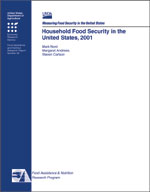Household Food Security in the United States, 2001
- by Mark Nord, Margaret Andrews and Steven Carlson
- 10/21/2002
Overview
Eighty-nine percent of American households were food secure throughout the entire year 2001. The rest were food insecure at least some time during the year, meaning they did not always have access to enough food for active, healthy lives for all household members because they lacked sufficient money or other resources for food. The prevalence of food insecurity rose from 10.1 percent in 1999 to 10.7 percent in 2001, and the prevalence of food insecurity with hunger rose from 3.0 percent to 3.3 percent during the same period. This report, based on data from the December 2001 food security survey, provides the most recent statistics on the food security of U.S. households, as well as on how much they spent for food and the extent to which food-insecure households participated in Federal and community food assistance programs.
Download
-
Entire report
Download PDF -
Abstract, Contents, Summary
Download PDF -
Introduction
Download PDF -
Section 1. Household Food Security
Download PDF -
Section 2. Household Spending on Food
Download PDF -
Section 3. Use of Federal and Community Food Assistance Programs
Download PDF -
References
Download PDF -
Appendix A: Household Responses to Questions in the Food Security Scale
Download PDF -
Appendix B: Background on the U.S. Food Security Measurement Project
Download PDF -
Appendix C: USDA?s Thrifty Food Plan
Download PDF -
Appendix D: Changes in Prevalence of Food Insecurity and Hunger by State, 1996-98 (average) to 1999-2001 (average)
Download PDF

